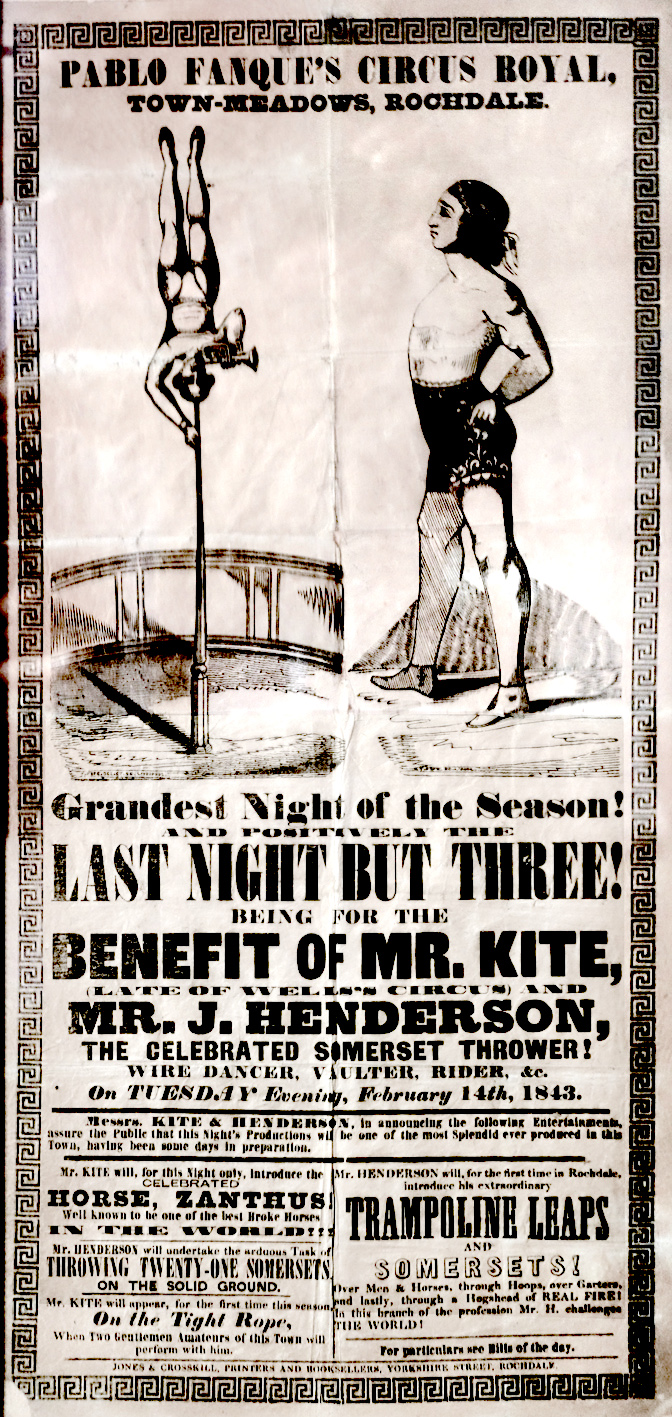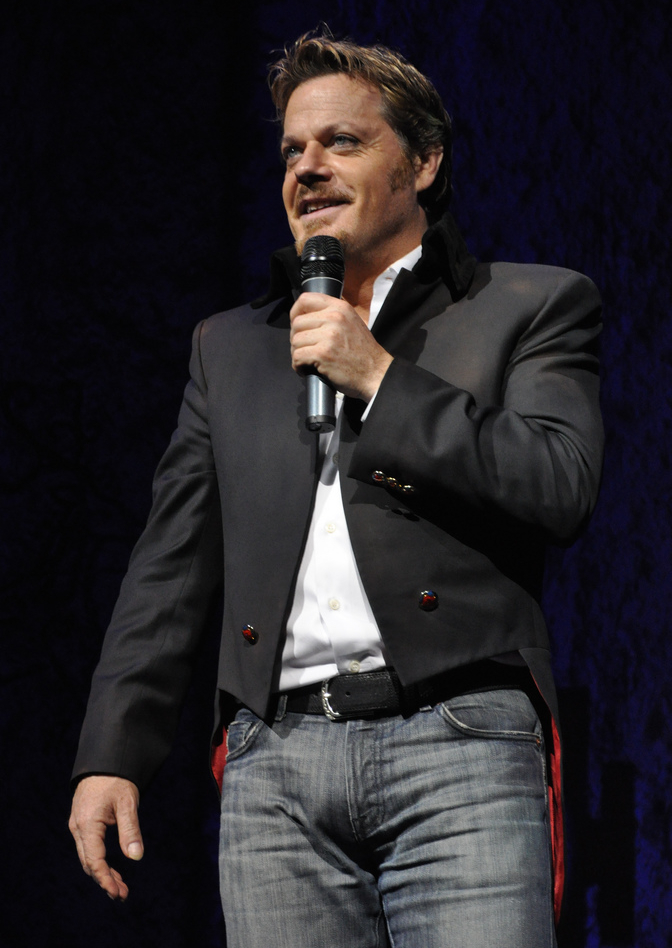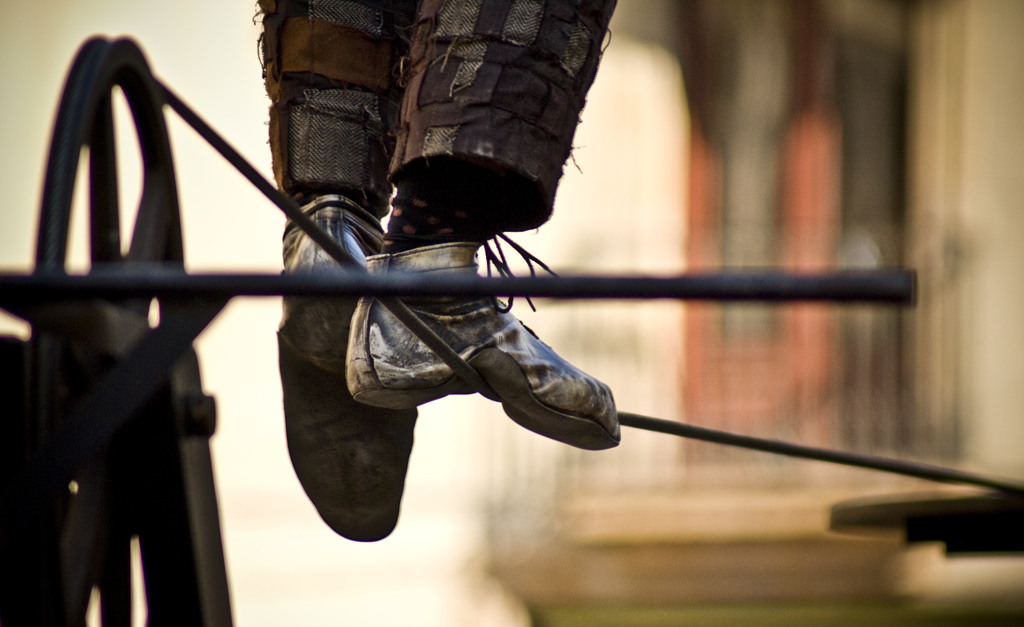|
William Kite
William Kite ( – after 1845) was a 19th-century circus performer, best known as being the "Mr. Kite" from the Beatles song "Being for the Benefit of Mr. Kite!" Biography Kite came from a circus family. He was born in Lambeth, London, about 1825. His father, James Kite, was a circus proprietor, and the first to visit Knott Mill Fair, Manchester, in 1806. James Kite formed his own company around 1810, travelling as "Kite's Pavilion Circus." William Kite was a performer at Wells's Circus from 1842 to 1843 and in Pablo Fanque's circus in Rochdale from 1843 to 1845. A "Miss Kite", possibly a sister, also performed in Fanque's circus, in Burnley, in 1845. His daughter, Elizabeth Ann Kite, later performed in the circus as an "Equestrienne". She married Eugene Gaertner, a member of another circus family. "Being for the Benefit of Mr. Kite!" song A broadside poster advertising Pablo Fanque's Circus Royal show in Rochdale, dated 14 February 1843, inspired, and provided many of the l ... [...More Info...] [...Related Items...] OR: [Wikipedia] [Google] [Baidu] |
Benefit Performance
A benefit performance is a type of live entertainment which is undertaken for a cause. In its original usage, benefit performances were opportunities for an actor to supplement his/her income. In its modern usage, benefit performances are given to raise money for or awareness of a humanitarian cause, or for the immediate benefit of an audience. As a benefit for performers The concept of a benefit performance originates in England where they were used from at least 1685 to about 1870. During this time, a theater performer would be hired with a contract typically stipulating at least one benefit performance a year. For this event, the actor's employer, the theater company, would offer the ''bénéficiaire'' (as the recipient was termed) 100% (in the case of a "clear" benefit) of the event's proceeds as a bonus pay. Other forms of the benefit were the "half-clear" benefit in which the artist was entitled to 50% of the proceeds. There were also instances of multiple actors appearin ... [...More Info...] [...Related Items...] OR: [Wikipedia] [Google] [Baidu] |
Circus Owners
A circus is a company of performers who put on diverse entertainment shows that may include clowns, acrobats, trained animals, trapeze acts, musicians, dancers, hoopers, tightrope walkers, jugglers, magicians, ventriloquists, and unicyclists as well as other object manipulation and stunt-oriented artists. The term ''circus'' also describes the performance which has followed various formats through its 250-year modern history. Although not the inventor of the medium, Philip Astley is credited as the father of the modern circus. In 1768, Astley, a skilled equestrian, began performing exhibitions of trick horse riding in an open field called Ha'Penny Hatch on the south side of the Thames River, England. In 1770, he hired acrobats, tightrope walkers, jugglers and a clown to fill in the pauses between the equestrian demonstrations and thus chanced on the format which was later named a "circus". Performances developed significantly over the next fifty years, with large-scale th ... [...More Info...] [...Related Items...] OR: [Wikipedia] [Google] [Baidu] |
People From Lambeth
A person ( : people) is a being that has certain capacities or attributes such as reason, morality, consciousness or self-consciousness, and being a part of a culturally established form of social relations such as kinship, ownership of property, or legal responsibility. The defining features of personhood and, consequently, what makes a person count as a person, differ widely among cultures and contexts. In addition to the question of personhood, of what makes a being count as a person to begin with, there are further questions about personal identity and self: both about what makes any particular person that particular person instead of another, and about what makes a person at one time the same person as they were or will be at another time despite any intervening changes. The plural form "people" is often used to refer to an entire nation or ethnic group (as in "a people"), and this was the original meaning of the word; it subsequently acquired its use as a plural form of per ... [...More Info...] [...Related Items...] OR: [Wikipedia] [Google] [Baidu] |
George Burns
George Burns (born Nathan Birnbaum; January 20, 1896March 9, 1996) was an American comedian, actor, writer, and singer, and one of the few entertainers whose career successfully spanned vaudeville, radio, film and television. His arched eyebrow and cigar-smoke punctuation became familiar trademarks for over three-quarters of a century. He and his wife Gracie Allen appeared on radio, television and film as the comedy duo Burns and Allen. At the age of 79, Burns experienced a sudden career revival as an amiable, beloved and unusually active comedy elder statesman in the 1975 film ''The Sunshine Boys'', for which he won the Academy Award for Best Supporting Actor. Burns was only a Tony Award shy of being one of the few EGOT award recipients in the American entertainment industry, winning an Emmy, a Grammy, and an Oscar. Burns became a centenarian in 1996, continuing to work until just weeks before his death of cardiac arrest at his home in Beverly Hills, shortly after his hundr ... [...More Info...] [...Related Items...] OR: [Wikipedia] [Google] [Baidu] |
Eddie Izzard
Edward John Izzard (; born 7 February 1962) is a British stand-up comedian, actor and activist. Her comedic style takes the form of what appears to the audience as rambling whimsical monologues and self-referential pantomime. Izzard's stand-up comedy tours have included '' Live at the Ambassadors'' (1993), ''Definite Article'' (1996), '' Glorious'' (1997), '' Dress to Kill'' (1998), ''Circle'' (2000), ''Stripped'' (2009), '' Force Majeure'' (2013) and, most recently, ''Wunderbar'' (2022). She starred in the 2007 television series '' The Riches'', and has appeared in numerous films, including ''Ocean's Twelve'' and ''Ocean's Thirteen'', ''Shadow of the Vampire'', ''The Cat's Meow'' and ''Valkyrie''. Izzard has also worked as a voice actor on films such as ''Five Children and It'', '' The Chronicles of Narnia: Prince Caspian'', '' Abominable'' and the Netflix original series ''Green Eggs and Ham''. Among various accolades, she won two Primetime Emmys for ''Dress to Kill'' and ... [...More Info...] [...Related Items...] OR: [Wikipedia] [Google] [Baidu] |
Across The Universe (film)
''Across the Universe'' is a 2007 jukebox musical romantic drama film directed by Julie Taymor, centered on songs by the Beatles. The script is based on an original story credited to Taymor, Dick Clement, and Ian La Frenais, and based on the song of the same name by Lennon–McCartney. It incorporates 34 compositions originally written by members of the Beatles. The film stars Evan Rachel Wood, Jim Sturgess, Joe Anderson and T.V. Carpio, and introduces Dana Fuchs and Martin Luther McCoy as actors. Cameo appearances are made by Bono, Eddie Izzard, Joe Cocker, and Salma Hayek, among others. ''Across the Universe'' premiered at the Toronto International Film Festival on September 14, 2007, and was theatrically released in the United States on October 12 by Columbia Pictures. The film received mixed reviews from critics, with many praising the visuals, cast and singing performances, though criticized the plot and direction. The film was a major box-office bomb, failing to earn ev ... [...More Info...] [...Related Items...] OR: [Wikipedia] [Google] [Baidu] |
John Sanger
John Sanger (1816 – 22 August 1889) was an English circus proprietor. Biography He was born at Chew Magna, Somerset, in 1816, the son of an old sailor who had turned showman. In 1845 he started with his brother George Sanger a conjuring exhibition at Birmingham. The venture was successful, and the brothers, who had been interested spectators of the equestrian performances at Astley's Amphitheatre, London, then started touring the country with a circus entertainment consisting of a horse and pony and three or four human performers. This enterprise was a success from the beginning, and in due course John and George Sanger became lessees of the Agricultural Hall, London, and there produced a large number of elaborate spectacles. In 1871 the Sangers leased Astley's Amphitheatre where they gave an equestrian pantomime every winter, touring in the summer with a large circus. Subsequently the partnership was dissolved, each brother producing his own show. John Sanger died while tou ... [...More Info...] [...Related Items...] OR: [Wikipedia] [Google] [Baidu] |
Tightrope
Tightrope walking, also called funambulism, is the skill of walking along a thin wire or rope. It has a long tradition in various countries and is commonly associated with the circus. Other skills similar to tightrope walking include slack rope walking and slacklining. Types Tightwire is the skill of maintaining balance while walking along a tensioned wire between two points. It can be done either using a balancing tool (umbrella, fan, balance pole, etc.) or "freehand", using only one's body to maintain balance. Typically, tightwire performances either include dance or object manipulation. Object manipulation acts include a variety of props in their acts, such as clubs, rings, hats, or canes. Tightwire performers have even used wheelbarrows with passengers, ladders, and animals in their act. The technique to maintain balance is to keep the performer's centre of mass above their support point—usually their feet. Highwire is a form of tightwire walking but performed at much g ... [...More Info...] [...Related Items...] OR: [Wikipedia] [Google] [Baidu] |
Burnley
Burnley () is a town and the administrative centre of the wider Borough of Burnley in Lancashire, England, with a 2001 population of 73,021. It is north of Manchester and east of Preston, at the confluence of the River Calder and River Brun. The town is located near the countryside to the south and east, with the towns of Padiham and Brierfield to the west and north respectively. It has a reputation as a regional centre of excellence for the manufacturing and aerospace industries. The town began to develop in the early medieval period as a number of farming hamlets surrounded by manor houses and royal forests, and has held a market for more than 700 years. During the Industrial Revolution it became one of Lancashire's most prominent mill towns; at its peak, it was one of the world's largest producers of cotton cloth and a major centre of engineering. Burnley has retained a strong manufacturing sector, and has strong economic links with the cities of Manchester and Leed ... [...More Info...] [...Related Items...] OR: [Wikipedia] [Google] [Baidu] |
Circus
A circus is a company of performers who put on diverse entertainment shows that may include clowns, acrobats, trained animals, trapeze acts, musicians, dancers, hoopers, tightrope walkers, jugglers, magicians, ventriloquists, and unicyclists as well as other object manipulation and stunt-oriented artists. The term ''circus'' also describes the performance which has followed various formats through its 250-year modern history. Although not the inventor of the medium, Philip Astley is credited as the father of the modern circus. In 1768, Astley, a skilled equestrian, began performing exhibitions of trick horse riding in an open field called Ha'Penny Hatch on the south side of the Thames River, England. In 1770, he hired acrobats, tightrope walkers, jugglers and a clown to fill in the pauses between the equestrian demonstrations and thus chanced on the format which was later named a "circus". Performances developed significantly over the next fifty years, with large-scale theat ... [...More Info...] [...Related Items...] OR: [Wikipedia] [Google] [Baidu] |
Rochdale
Rochdale ( ) is a large town in Greater Manchester, England, at the foothills of the South Pennines in the dale on the River Roch, northwest of Oldham and northeast of Manchester. It is the administrative centre of the Metropolitan Borough of Rochdale, which had a population of 211,699 in the 2011 census. Located within the historic boundaries of the county of Lancashire. Rochdale's recorded history begins with an entry in the Domesday Book of 1086 under "Recedham Manor". The ancient parish of Rochdale was a division of the hundred of Salford and one of the largest ecclesiastical parishes in England, comprising several townships. By 1251, Rochdale had become important enough to have been granted a Royal charter. Rochdale flourished into a centre of northern England's woollen trade, and by the early 18th century was described as being "remarkable for many wealthy merchants". Rochdale rose to prominence in the 19th century as a mill town and centre for textile manufacture ... [...More Info...] [...Related Items...] OR: [Wikipedia] [Google] [Baidu] |



_1938.jpg)




